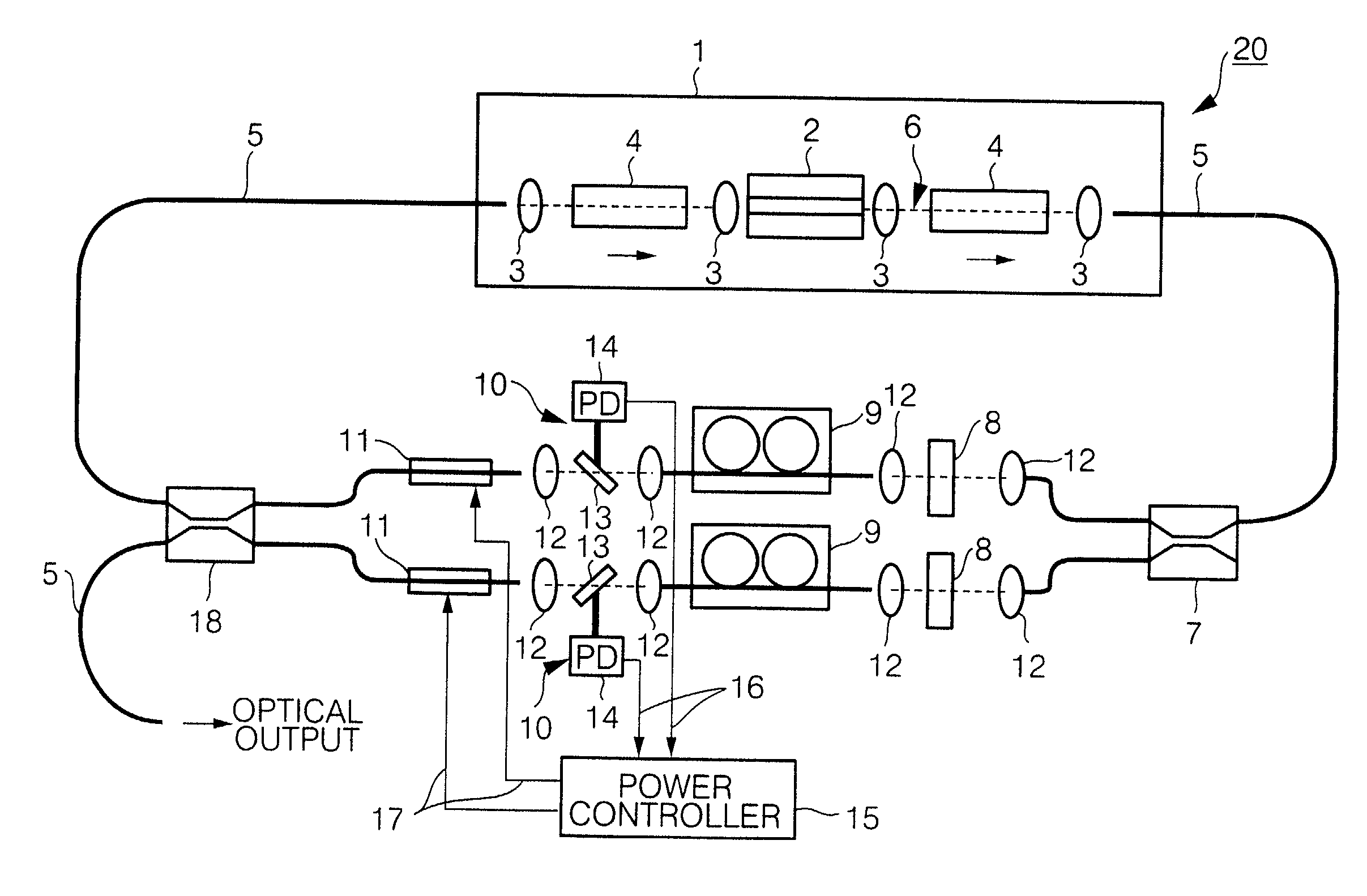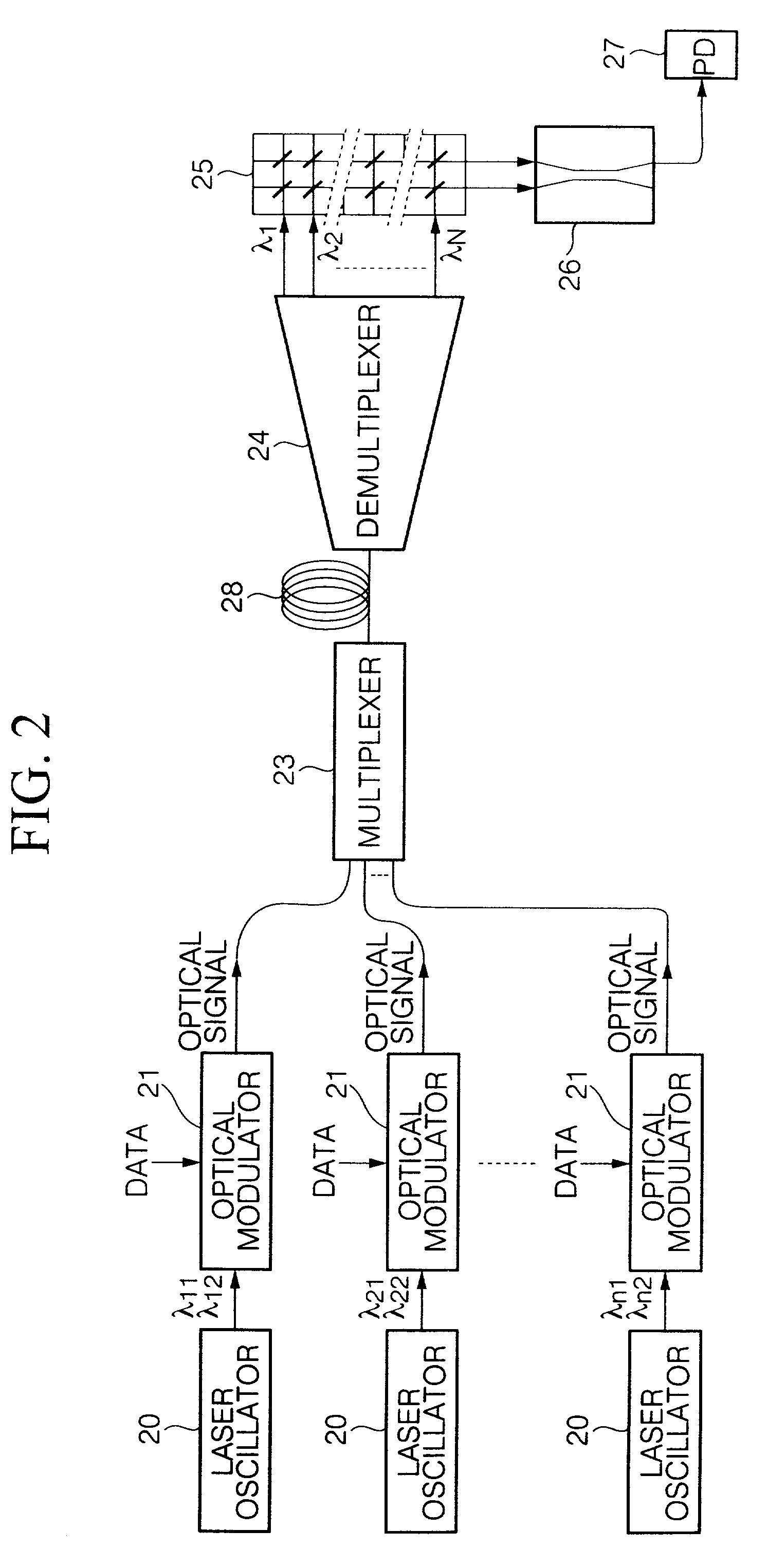Laser oscillator, optical communication method and system
a laser resonator and optical communication technology, applied in the field of laser resonators and optical communication methods and systems, can solve the problems of large change in oscillating frequency, inability to demodulate data, and inability to guarantee the resonant frequency of laser resonators attempting synchronous oscillation. to achieve the effect of increasing the reliability of optical communication systems
- Summary
- Abstract
- Description
- Claims
- Application Information
AI Technical Summary
Benefits of technology
Problems solved by technology
Method used
Image
Examples
embodiment 1
[0040]FIG. 1 shows the constitution of a laser oscillator according to a first embodiment of the present invention. As shown in FIG. 1, a semiconductor light amplifier 1 is provided as a light-amplifying medium which operates in a gain saturation state, and comprises isolators 4, which are connected to the input and output of a semiconductor light-amplifying element 2 (optical negative feedback element), comprising a semiconductor waveguide, with collimating lenses 3 therebetween, the lenses 3 forming a collimate beam 6, and two additional lenses 3 which couple the semiconductor light amplifier 1 to optical fibers 5.
[0041]The semiconductor light-amplifying element 2 amplifies light by stimulated emission in the same manner as a semiconductor laser, but has features for blocking end-face reflection, such as an anti-reflection coat and diagonal emission faces. A window structure having a band-gap is provided in order to reduce the rate of absorption near the emission faces, and preven...
embodiment 2
[0052]FIG. 2 is a block diagram showing an optical communication method according to a second embodiment of the present invention. As shown in FIG. 2, an optical communication system is provided with a transmitting section, a receiving section, and a transmission path 28 therebetween. The transmitting section comprises, for example, a plurality of laser oscillators 20 according to the first embodiment, which generate laser light (at two simultaneous wavelengths laser oscillation in this example) such as λ11, λ12 (i=1, 2, . . . n). The 2n wavelengths are set to different values. Optical modulators 21 create optical signals by encoding simultaneously at two wavelengths based on data to be transmitted, and a multiplexer 23 multiplexes the optical signals and transmits them in a single transmission via the transmission path 28.
[0053]In the receiving section, a demultiplexer 24 temporarily demultiplexes all the wavelength components. A wavelength multiplexer / demultiplexer using an array ...
embodiment 3
[0056]FIGS. 3 and 4 are diagrams showing an optical communication method according to a third embodiment of the present invention. FIG. 3 shows the constitution of a transmitting section, which is the same as the second embodiment in that it comprises a plurality of units for obtaining optical signals by using optical modulators 21 to encode data to be added to laser light from the laser oscillators 20, simultaneously oscillated at two wavelengths.
[0057]The multiplexer 23 multiplexes the optical signals, and the demultiplexer 24 demultiplexes them into their separate wavelength components λ1, λ2, . . . , λN. Thereafter, an N×N optical switch 31 rearranges the simultaneously oscillation wavelengths λ11, λ12 (i=1, 2, . . . , n) by dividing them into two wavelength groups λ11, λ21, . . . , λn1 and λ12, λ22, . . . , λ12. Moreover, two multiplexers 32 and 33 create wavelength-multiplexed signals by multiplexing each of the two wavelength groups, and transmit them along independent and eq...
PUM
 Login to View More
Login to View More Abstract
Description
Claims
Application Information
 Login to View More
Login to View More - R&D
- Intellectual Property
- Life Sciences
- Materials
- Tech Scout
- Unparalleled Data Quality
- Higher Quality Content
- 60% Fewer Hallucinations
Browse by: Latest US Patents, China's latest patents, Technical Efficacy Thesaurus, Application Domain, Technology Topic, Popular Technical Reports.
© 2025 PatSnap. All rights reserved.Legal|Privacy policy|Modern Slavery Act Transparency Statement|Sitemap|About US| Contact US: help@patsnap.com



